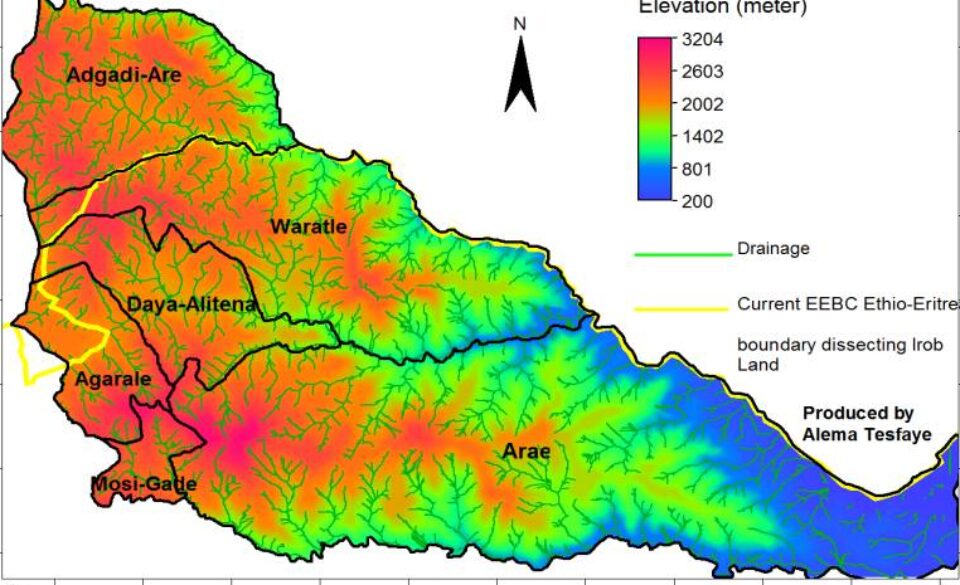Who Are The Irob People? (Source: Yahoo Answers)
Best Answer: The Irob people occupy a small semi-arid mountainous region, located in Agame, northeast Tigray. The Irobs who live in this geographic location speak the Saho language. But many other Irob descendants who live in the rest of Agame and some other places have adopted the Tigrigna language. Irob is an ethnic community made-up of three sub-groups: Adgadee-Are Bouknaitee-Are and Hasaballa. Adgadee-Are and Hasaballa are predominantly Tewahido Christians, while Bouknaitee-Are is Catholic.
All of the three Irob groups claim to be descendants of one man, Soummae. Neguse (King) Werede-Mehret from whose son, Soummae, the Irob people trace their lineage is, according to the oral history of the people and also several written documents, believed to had come from Tsira’e in Kilite-Awla’elo, Tigray, more than 700 years ago. That is around the time when the Salomonic dynasty retook the control of political power of the Ethiopian Empire from the Zagwe dynasty. It is recounted that Worede-Mehret, himself a local king, was descendant of Emperor Yitbarek of the Zagwe dynasty. Neguse Worede-Mehret and his followers left their ancestral land, probably, for political reasons related to the change of political power in the Ethiopian Empire. In fact, for many centuries they isolated themselves in this remote militarily strategic mountainous area keeping their distance from the political center.
When the Irob people came to the new land, they brought with them the Christian religion, which they have kept to date. At the site of their first permanent settlement, Halalisse, they built a Christian Church dedicated to St. Mary and they named it Kidane-Mehret (Covenant of Perpetual Mercy). The local residents still call the site Soumma’e Massoare (the Church of Soummae). In the memory of their ancestral land, they gave the name Tsira’e to the mountain overlooking the site of the first permanent settlement.
Until few decades ago, Irob land was a source of the best quality of honey, livestock and dairy products that used to dominate the regional markets. During the last three decades or so, because of drought and other factors, the region rapidly became one of the poorest spots. The problem is rooted mainly in the ecological and environmental conditions. Deforestation is almost complete in this mountainous region. The rare rainfalls, which usually come in the form of sudden heavy downpours, the irregularities of the surface and centuries of poor farming practices have combined to facilitate the erosion and depletion of the soil. The falls and flood have carved much of the topography, changing it into rows of hollows and hills. The gravel, sand and topsoil have been washed off, exposing the bedrock to the surface in almost all places.
In the Irob region is very densely populated and the holdings of cultivated land per household are very small and unproductive. During the last decade or so the people farmed by terracing the hillsides. The land needs continuous maintenance so that it is not swept away by eventual sudden downpours. Now that the peasants are dislocated from their villages because of the invasion, the hard work of terracing or maintaining the hillside lands has been aborted. This year’s unusually heavy rains have compounded the problem.
The Irob lived for centuries between two culturally different societies: the highland Christians whose economic life is mainly based on agriculture and the low land Muslims whose economy is mainly based on pasturing. This geographical location allowed the Irob people to have socio-cultural interaction with both, hence, a combination of both highland and lowland cultures are manifested in the Irob culture and way of life. There are some cultural norms and ways of life the Irob people have in common with lowlanders with whom they share the language (Saho). However, they are much more connected with the Christian peoples of the hinterland than they are to the lowland people of the region. Religion, cultural food, folklore, marriage customs, social organizations etc., are almost identical to those of Tigrigna speaking highlanders with special historical and cultural bonds with Agame people with whom they share the same Woldu-Subagadis Customary Law, foods like Tihlo, the original Maess etc.
The history of education in Irob is strictly related to the Catholic Church. Catholicism was introduced to central Irob (Buknaiti-Are) in 1845. As soon as the Catholic missionaries established roots in the locality, they built a school (Lideta) in Alitena in 1845. By 1850, it was legally recognized by Dej. Woubie, a native of northern Gondar and the then governor of Tigray. The curriculum included Geez, Amharic, primary science and mathematics. Latin, French, philosophy, and theology were taught in higher levels.
http://www.oocities.com/~dagmawi/NewsJan…
